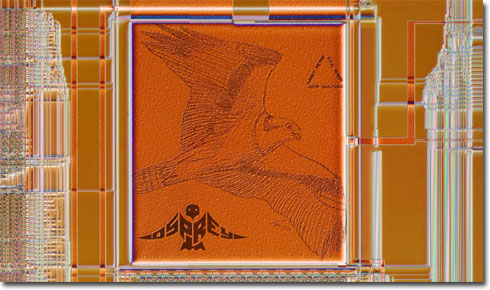Flying Osprey
|
A Hewlett-Packard design team headed by Howard Hilton in Lake Stevens, Washington was responsible for placing what is perhaps the World's smallest rendition of an osprey on a decimation filter integrated circuit utilized in signal analyzer instruments. This chip was designed with Hewlett-Packard's then state-of-the-art CMOS-26 process, and was code-named Osprey or 1FZ9. Released in August 1990, the logical design was produced by Dr. John Guilford at the Hewlett-Packard Lake Stevens, Washington facility, while the physical design was crafted by Garry Petrie and Paul Nuber in Fort Collins, Colorado. The original artwork for the osprey was drawn by Dr. Guilford's wife as a pencil sketch and digitized by Lynn Mahnke. The chip was loaned for imaging by Dr. John Guilford of Agilent Technologies (formerly Hewlett Packard). Ospreys are large, predatory birds whose scientific name, Pandion haliaetus, means "sea eagle." Their sharp talons are well adapted for catching slippery fish and they feature a rotating outer toe that can grasp objects from the front or the back. The brown and white plumage of the species often causes confusion and viewers frequently mistake ospreys for bald eagles from a distance. Sometimes referred to as fish hawks, ospreys are well known for hovering over potential prey from great heights and then plunging dramatically, feet first, into the water with a crash. Their flexible wings are extremely durable and can withstand diving speeds of up to 50 miles per hour. Combined with their talons, which can snap shut in a fraction of a second, the raptors are amply equipped to easily secure their meals. Although some anglers may not appreciate the avian competition, ospreys have excellent eyesight and may be utilized by fisherman to locate large schools of fish. Ospreys naturally use trees for nesting, but readily adapt to utilizing manmade structures, such as utility poles and navigation buoys. Extremely loyal to their nesting sites, male ospreys prefer to remain close to the area inhabited by their ancestors and continue to add twigs, sticks, seaweed, and other debris to their huge nest piles year after year. Females, however, may disperse hundreds of miles from their place of origin, settling wherever they find a suitable mate, which is largely dependent on their nest quality and location.Once coupled, male and female ospreys generally remain together for life, but may separate if mating is unproductive. If eggs are successfully produced, however, both parents take part in their protection, defending the nest aggressively from anyone or anything that gets too close. After they hatch, the young ospreys also need safeguarding since they are blind and helpless, and the male secures food for the family while the mother watches over them. When the parents believe the fledglings are ready, they withhold food in order to encourage them to leave the nest. However, some fledged young do not travel far after leaving home, instead visiting neighboring nests where they are fed by other parents. |
© 1995-2025 by Michael W. Davidson and The Florida State University. All Rights Reserved. No images, graphics, software, scripts, or applets may be reproduced or used in any manner without permission from the copyright holders. Use of this website means you agree to all of the Legal Terms and Conditions set forth by the owners.
This website is maintained by our
|
